A child is seriously injured or killed every 17 weeks on their way to or from school on Toronto’s roads. That’s a sobering statistic for Canada’s largest city and is the reason that school children are one of the six emphasis areas of the City of Toronto’s Vision Zero Road Safety Plan.
First launched in 2018, as part of the city’s Vision Zero initiatives, Toronto’s Active and Safe Routes to School (ASRTS) pilot project has been testing ways to improve safety along designated routes to school and increase student participation in walking and cycling for school journeys. Led by the City of Toronto’s Transportation Services division, the pilot has rolled out at nine schools over the past four years. At each school, the initiative has typically included the installation of new street features (wayfinding signs, sidewalk stencils, and pavement markings), combined with education and encouragement events (maps, handouts, skills rodeos, and community walks).
The ASRTS project has benefitted from a fruitful partnership between the municipality, school boards, Green Communities Canada (GCC), and CultureLink Settlement and Community Services. These project partners came together regularly through the Toronto Active and Safe School Travel (ASST) Hub committee to plan the communication strategies, events, and evaluation for the pilot.
GCC has had a pivotal role in the pilot over the past two years as Toronto Public Health staff had to pull back from leading the project due to the COVID-19 pandemic. GCC stepped in to fill that gap by chairing the Toronto ASST Hub and providing project coordination for the 2020-2022 phase. “Our staff have been delivering School Travel Planning with Toronto school communities for over a decade, so we are very invested in this work and we were keen to step up and fill that project management role during the pandemic to ensure continued progress on road safety for school children in Toronto” explained Kate Berry, Program Director at Green Communities Canada.
Below, we take a look at the key features of the pilot at schools that most recently participated.
Street Features
Several ‘ASRTS street features’ were installed at each participating school site. These included road markings, sidewalk activity stencils, and wayfinding signage to encourage children to walk, cycle or wheel to school, and zebra crosswalks at all stop-controlled intersections. The ASRTS street features also included ‘School Route’ signs aimed at drivers to identify school routes and increase driver attention to the presence of children and encourage slower speeds and increase safety.
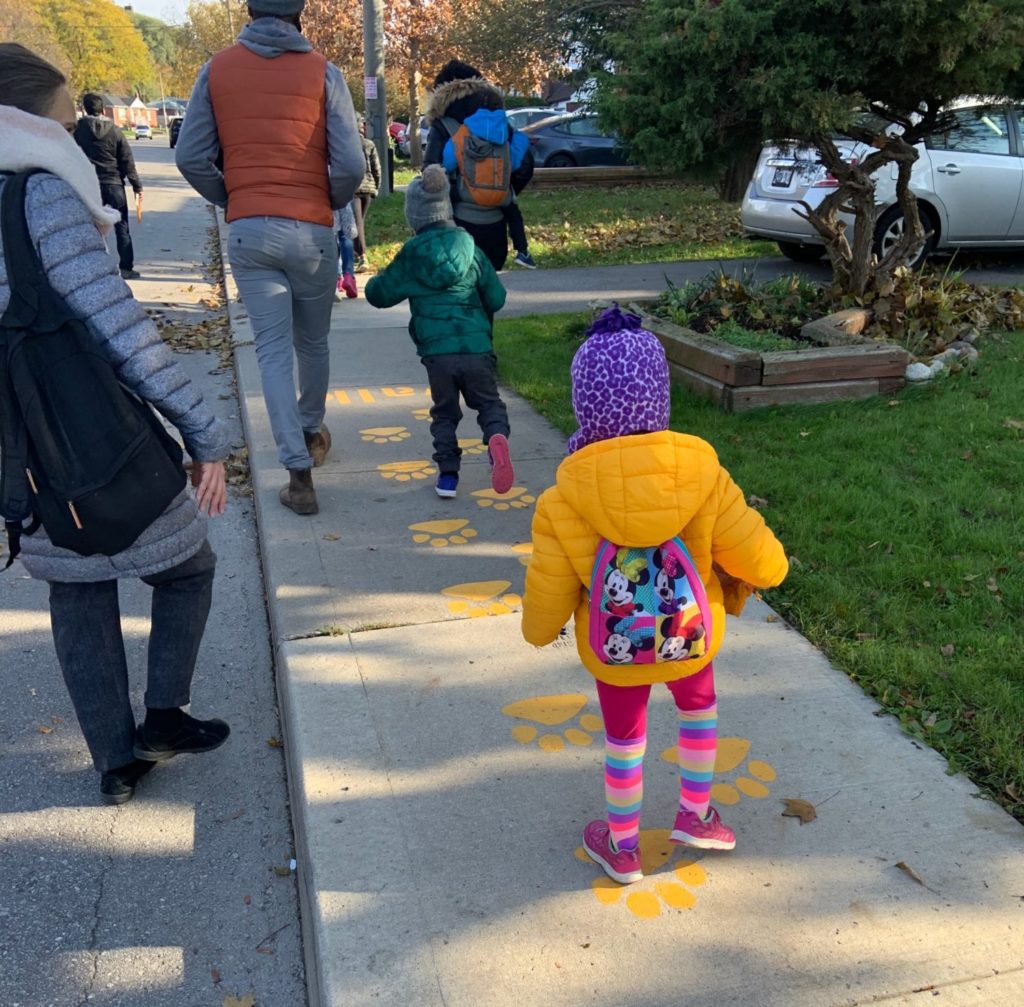
Sidewalk Activity Stencils at Hillmount Public School. Photo by: Green Communities Canada
“It promotes a conversation between my daughter and us (depending on who is walking her to school) on how long it will take to get there. It motivates her to get to the next set of paw prints or tire hops. She talks about what she has learned at school about safely walking home.” – Family Survey Respondent
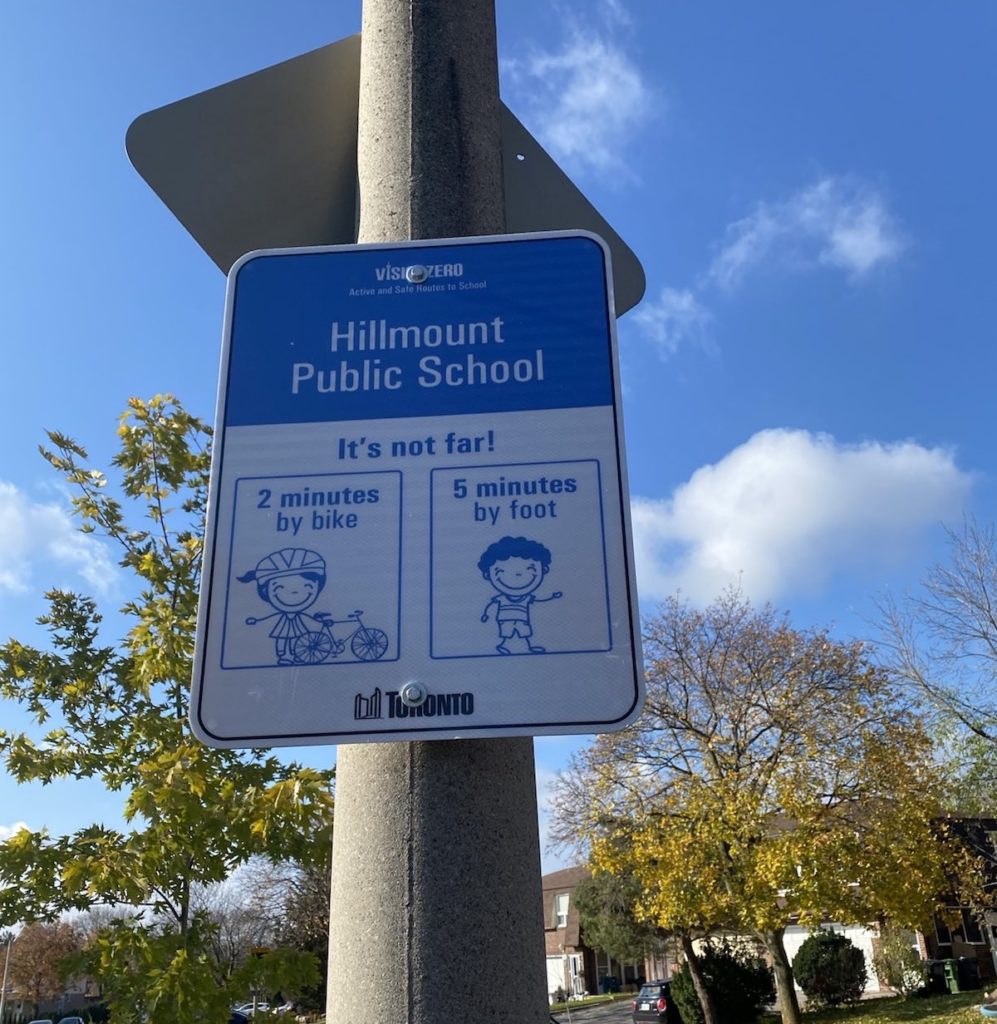
Wayfinding Signs at Hillmount Public School. Photo by: Shelley Carroll
“The signs and the stencils help make walking to school a fun “game”.” – Family Survey Respondent

Crosswalk Paint Markings at Jean Lumb and Bishop MacDonnell. Photo by: Green Communities Canada
“You can really see the difference that these interventions make. Kids love hopping and skipping through the sidewalk activities and enjoy getting creative with stencils,” remarked Isooda Niroomand, School Travel Planning Program Manager at Green Communities Canada.
Community Walks
Education staff from CultureLink visited each school and led a 60-minute guided Community Walk, which was open to everyone in the school community to attend as an opportunity to tour the new street features and ask questions about their intended purposes. Thanks to the support this pilot received from elected officials and principals, these community walks turned out to be very successful and engaged many families and residents.
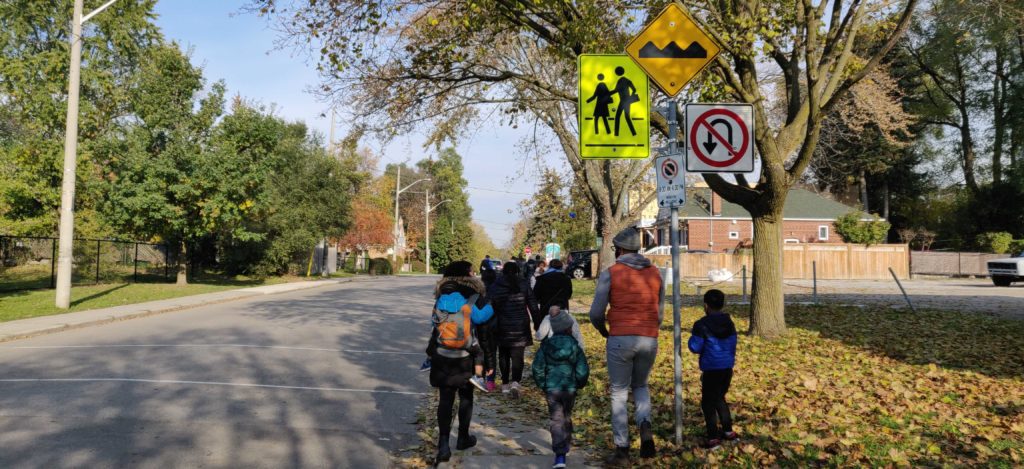
Group on a Community Walk at George Webster Public School. Photo by: Green Communities Canada
“I think it definitely is worthwhile as it promotes healthy active lifestyles, community awareness and connection, as well as encourages environmentally friendly ways of moving around the city” – School Principal Survey Respondent

Group on Community Walk at Hillmount Public School. Photo by: Shelley Carroll
Educational Handouts
The City of Toronto developed an educational handout for each school that was printed and sent to students and their families to provide information about the new zebra crosswalks, sidewalk activity stencils, and signage installed near their school. The map on the back of the handout illustrated the locations of the improvements around each school site to help families plan their daily routes to school.
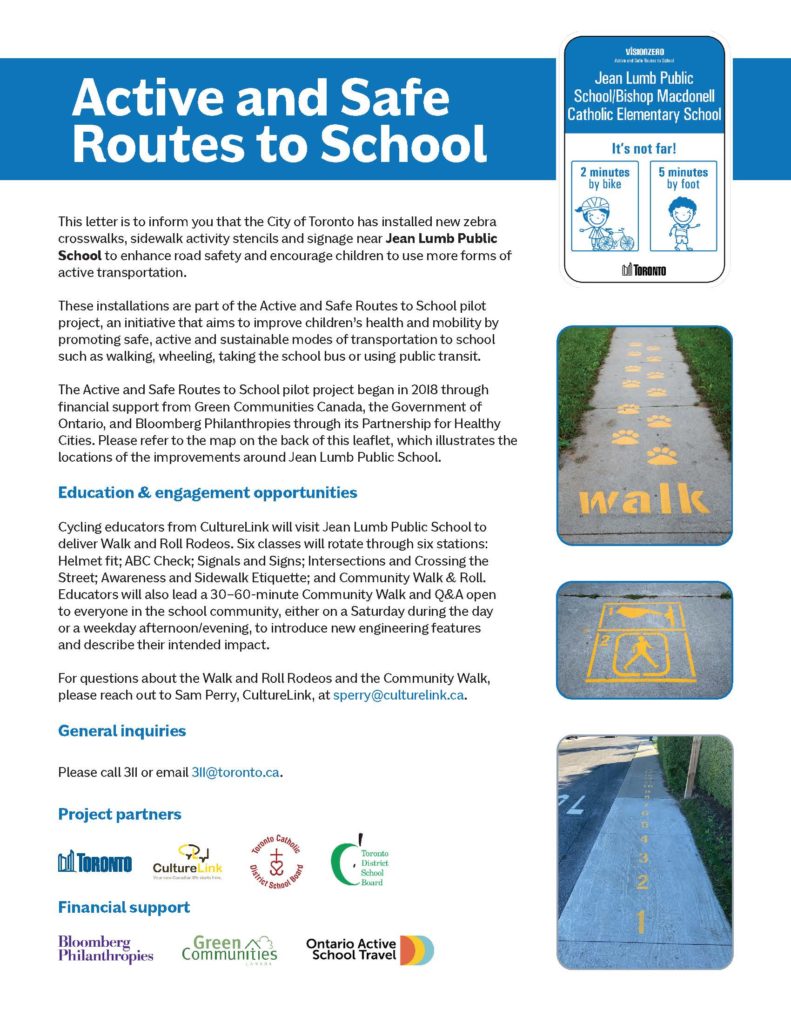
Handout sent to families at Jean Lumb Public School. A pdf version can be downloaded for reference.

Handout sent to families at Bishop Macdonnell Catholic Elementary School. A pdf version can be downloaded for reference.
Active Transportation Rodeos
CultureLink Educators provided an ‘Active Transportation Rodeo’ for Grade 3-5 students at each school. During the 2.5-hour session, the students rotated through six stations: Helmet fit; ABC Check; Signals and Signs; Intersections and Crossing the Street; Awareness and Sidewalk Etiquette; and Community Walk & Roll for students to learn and practice walking and biking safely to school.
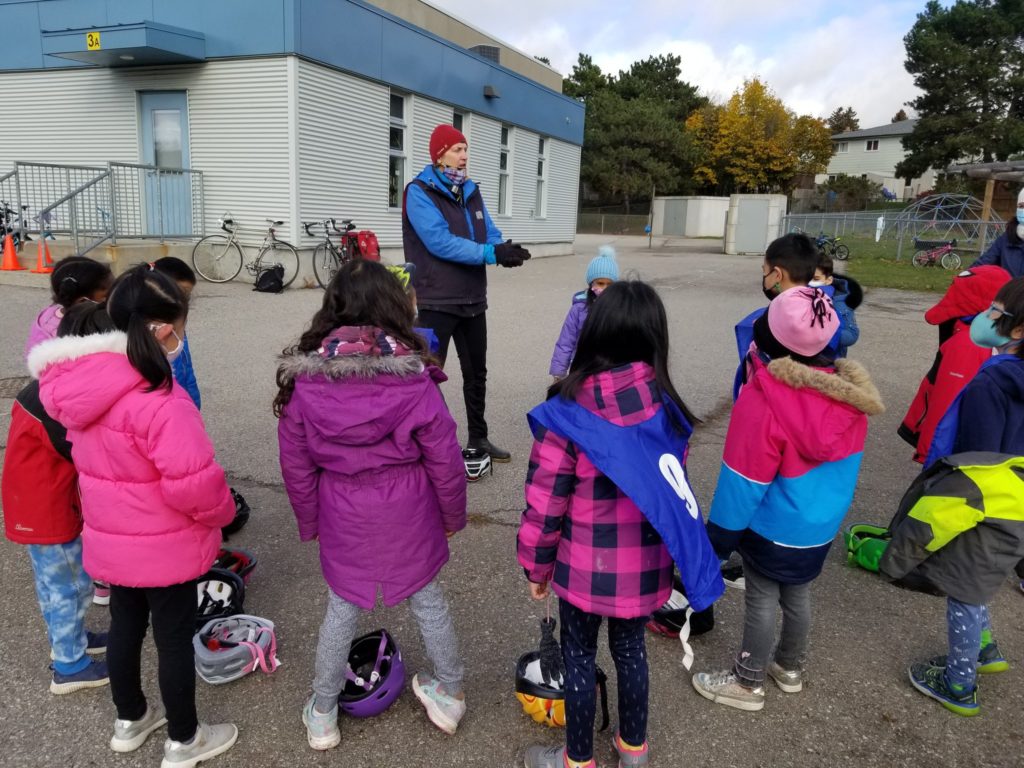
AT Rodeo held at Hillmount Public School. Photo by: Green Communities Canada
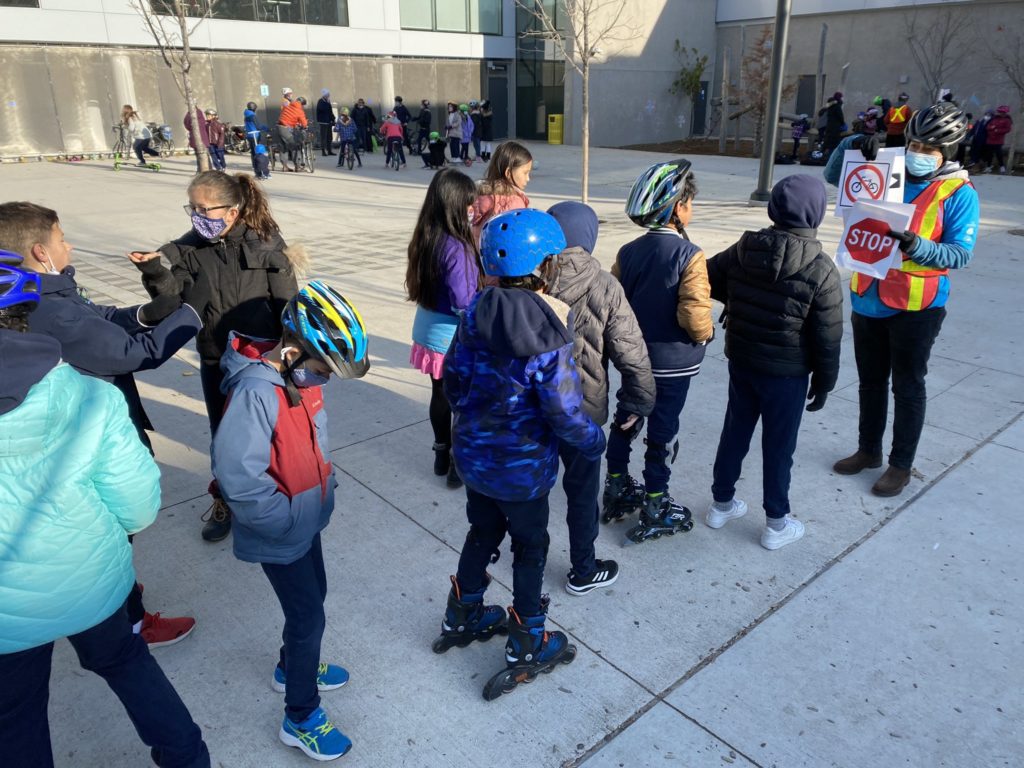
AT Rodeo held at Jean Lumb Public School/ Bishop Macdonnell Catholic Elementary School. Photo by: Green Communities Canada
Family Feedback
Whilst the Toronto ASRTS pilot’s features were very well received by families in the school communities, many remain concerned about traffic safety issues in their neighbourhoods, in particular unsafe driver behaviours, traffic speed and volume, and the lack of protected cycling infrastructure.
“I would never feel comfortable letting my kid go to school by himself with all the impatient drivers and hazardous driving in this area” – Family Survey Respondent
Overall, 79% of participants indicated that implementing more of the ASRTS pilot installations throughout the city would encourage more children to use active transportation more often to travel to/from school, but that as standalone items, they don’t change their traffic safety perceptions.
Final Thoughts
The pilot project had a number of key takeaways that can be valuable to others pursuing similar active school travel interventions in their communities. Notable findings include:
- 74% of parents interviewed/surveyed were aware of the pilot features, which is mostly attributed to ‘school communications’ and ‘noticing the features while walking, biking, and driving to school’
- Participants felt that of the various ASRTS features installed, the two that most improved their child’s trip to school were ‘sidewalk activity stencils’ (37%) and ‘school route signs for drivers’ (23%)
- Principals interviewed believed that replicating this program at other schools is worthwhile
“We know there is still work to do. We are keen to build on what we’ve learnt in this pilot and continue working with all Toronto Vision Zero partners to keep pushing towards safer streets where kids can travel actively,” reflected Niroomand.
To learn more about the Active and Safe Routes to School pilot project in Toronto, we encourage you to read the full Summary Report and sign-up for the Ontario Active School Travel (OAST) newsletter to get more stories like this directly to your inbox.
Special thanks to Councilors Brad Bradford and Shelley Carroll and their teams; TCDSB’s Trustee Norm Di Pasquale; the staff and students of participating schools, especially Principals Elizabeth Mankiewicz, Sohail Shaikh, Jaime DiGirolamo and Judith Kramer. Without your support, this project could not have happened.
The Toronto Active and Safe Routes to School Pilot was made possible through grants received from Bloomberg Philanthropies’ Partnership for Healthy Cities, which is a global network of 70 cities committed to saving lives by preventing non-communicable diseases, and from Ontario Active School Travel, a program of Green Communities Canada dedicated to children’s mobility, health, and happiness. The former provided $50,000 USD and the latter granted $60,000 CAD to help deliver this important initiative.
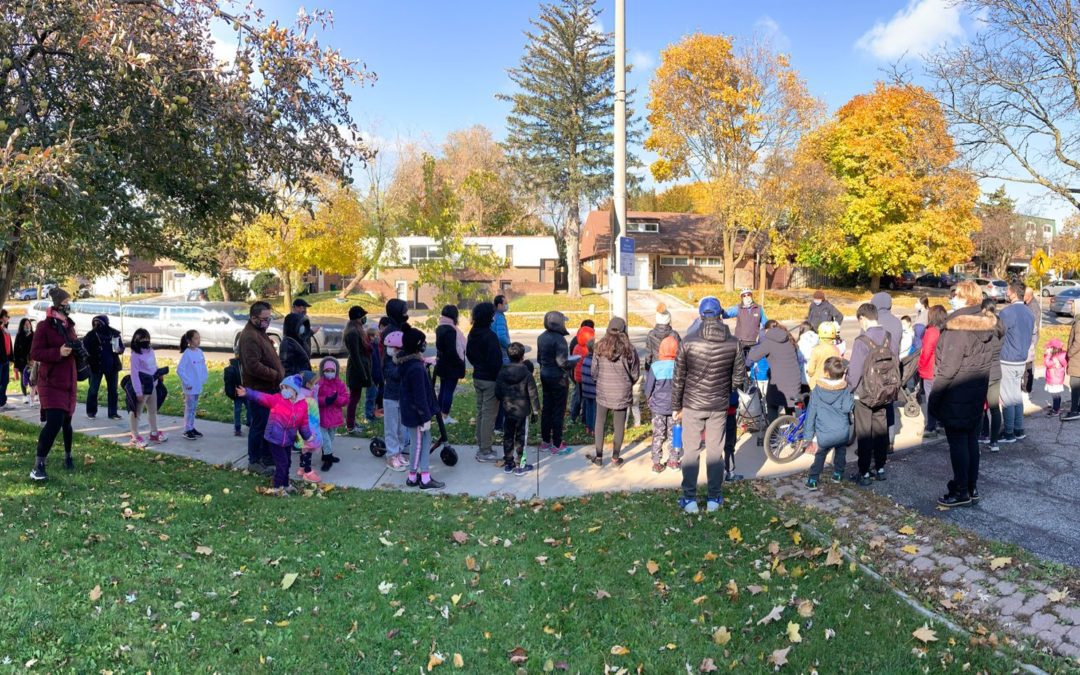
Recent Comments